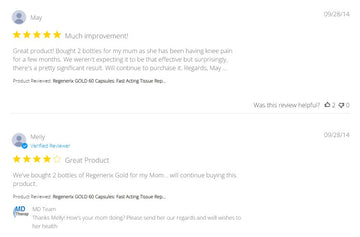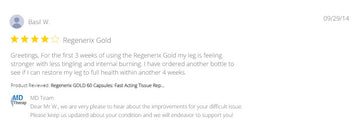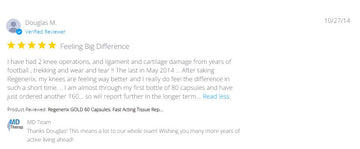Stationary Cycling (Upright): Joint-Friendly Cardio for Knee OA & Patellofemoral Pain
由 MD therapeutics 上 Aug 17, 2025
Why stationary cycling helps (the principles)
-
Low-impact, rhythmic motion: Cycling is a closed-chain, low-impact activity that promotes synovial fluid movement and joint lubrication while keeping ground-reaction forces minimal—making it easier to tolerate than many weight-bearing options. Major guidelines strongly recommend exercise (including low-impact aerobic work like cycling) for knee OA. American College of Rheumatology+1
-
Pain & function benefits: A meta-analysis found stationary cycling reduces pain and improves sport function in knee OA; trials of group cycling reported less pain with walking in mild–moderate OA. PubMed+1
-
PFPS support: For anterior knee (patellofemoral) pain, biking can build quadriceps and hip strength with controllable joint stress; cycling or aquatic training improved symptoms and muscle strength in athletes with PFPS. PMC
Quick setup cues:
Seat so your knee has a gentle 25–35° bend at the bottom of the stroke; start with low resistance, higher cadence (70–90 rpm); ride 10–20 min, 3–5×/week, adding 5 min/week toward 30–40 min as tolerated.
Limits of exercise alone
-
Systemic factors remain unaddressed (diet, sleep, stress, metabolic health).
-
Flares cap training load, causing stop-start progress.
-
Technique matters: Some need targeted strength and gait/seat-height tweaks.
-
Slow tissue remodeling: Cartilage/tendon adapt over months—consistent but patient work is required. (Hence the value of smart nutrition alongside cycling.) American College of Rheumatology
Why nutritional correction helps your results
-
Improve circulation for oxygen/nutrient delivery during recovery.
-
Promote repair with structural building blocks (collagen peptides, HA). PMC
-
Reduce excessive inflammation so training stays tolerable. PMC
-
Protect tissues from oxidative/catabolic stress during rehab. PMC
Botanicals & nutrients often paired with joint rehab
Notes blend traditional use with published research; evidence ranges from promising to mixed—discuss with your clinician.
Ginger (Zingiber officinale)
-
Tradition: Ayurveda & East Asian medicine for “rheumatism” and circulation. NCBIScienceDirect
-
Research: Meta-analyses/RCTs show mixed results for OA pain/function; some benefit, heterogeneity high. PubMed+1
Turmeric/Curcumin (Curcuma longa)
-
Tradition: Core Ayurvedic spice for joint comfort.
-
Research: Systematic reviews suggest standardized curcumin can reduce arthritis symptoms; bioavailability matters. PMCPubMed
Boswellia/Frankincense (Boswellia serrata)
-
Tradition: Ayurveda’s shallaki resin for joints.
-
Research: RCT meta-analysis reports improvements in pain and function vs. placebo/standard care. PMC
Winter Cherry / Ashwagandha (Withania somnifera)
-
Tradition: Adaptogen for resilience and musculoskeletal comfort.
-
Research: Double-blind trial in knee pain showed symptom benefits; broader reviews support immunomodulatory/anti-inflammatory effects. PubMedMDPI
Collagen peptides (Type II emphasis)
-
Concept: Provide peptides that may support cartilage metabolism and tendon/ligament integrity—useful alongside cycling’s mechanical stimulus.
-
Research: Recent meta-analysis suggests pain reduction in knee OA vs placebo (more high-quality RCTs still needed). PMC
Hyaluronic Acid (oral)
-
Concept: Contributes to joint lubrication/viscosity.
-
Research: 2024 systematic review: oral HA appears safe and effective for OA (more data still welcome), complementing exercise. PMC
Cat’s Claw (Uncaria spp.)
-
Tradition: Amazonian use for “rheumatism.”
-
Research: Placebo-controlled trial in knee OA reported symptom improvements; additional trials (incl. RA) suggest good tolerability. SpringerLinkNCBI
The practicality problem
-
Food-only dosing is hard: Culinary turmeric has low curcumin; “trial-like” intakes require impractically large daily amounts, and consistent ginger dosing is equally tough.
-
Pill-burden & cost stack up: Buying six–seven separate products (ginger, turmeric, boswellia, ashwagandha, collagen, HA, cat’s claw) often means many capsules per day and a higher monthly spend than one comprehensive formula.
A convenient all-in-one option: Regenerix Gold™
If you want cycling + nutrition without juggling multiple bottles:
-
What’s inside: Hydrolyzed Type II Collagen plus a proprietary blend of Ginger, Turmeric, Frankincense (Boswellia), Cat’s Claw, Winter Cherry (Ashwagandha), and Hyaluronic Acid—the same seven ingredients discussed above, combined to support healthy joint function. MD Therapeutics
-
Dosing: 2–3 capsules daily (brand FAQs state 2/day; some brand materials discuss higher intakes in certain cases—follow professional advice). MD Therapeutics+1
-
Price: $98 a bottle.
-
Why it fits here: One product covering seven evidence-linked ingredients is simpler—and typically more cost-effective—than buying 5–7 separate supplements.
-
Track record: The brand highlights professional recommendations and international use spanning years. MD Therapeutics+1
Supplements support healthy function; they don’t diagnose, treat, or cure disease. Check interactions (e.g., anticoagulants) and suitability with your clinician.
A simple cycling progression you can start this week
-
Week 1–2: 10–15 min, low resistance, cadence 70–90 rpm, 3–4×/wk
-
Week 3–4: 20–30 min, 4–5×/wk; add light intervals (1 min easy / 1 min a bit harder) if pain ≤3/10 and settles within 24 h
-
Support moves (2–3×/wk): Terminal knee extensions (band), mini-squats to chair, calf raises, side-lying hip abduction
-
If pain spikes: Drop resistance/cadence 20–30% and re-progress



